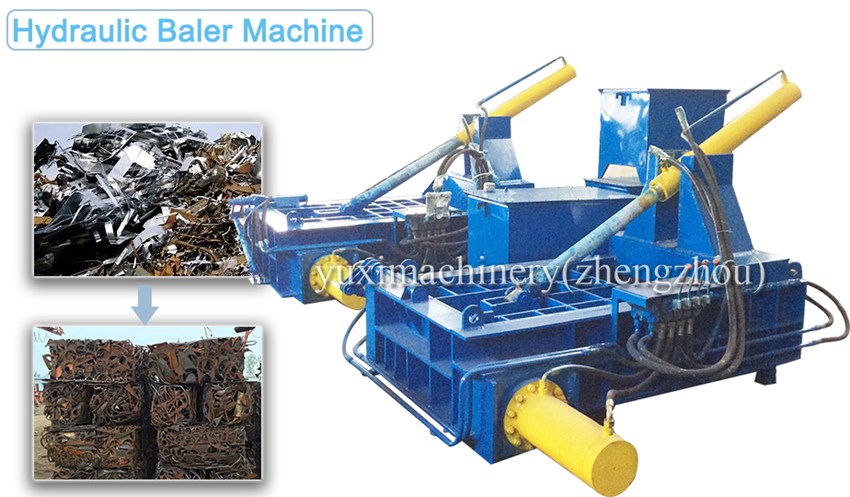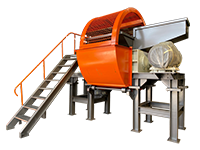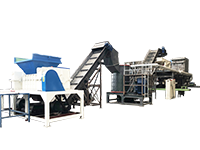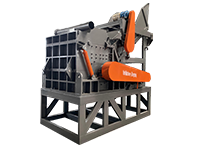In the scrap metal recycling industry, the performance shortcomings of hydraulic metal balers often become invisible thresholds restricting profitability—many practitioners have fallen into dilemmas such as "low compression density of equipment, unable to reduce transportation costs" and "poor site adaptability, time-consuming and expensive installation and commissioning". The core advantages of high-quality equipment that can efficiently process steel scraps and aluminum chips lie in "hydraulic system precision", "structural process details" and "scene-adaptive design".
Whether you are an entrepreneur who has just entered the metal recycling industry or a senior practitioner who wants to upgrade the production line, this guide will thoroughly dissect the selection logic, technical details and production line matching of hydraulic metal balers to help you avoid most pitfalls in equipment procurement and use.
1. First Understand the Core Technology: The "Performance Skeleton" of Hydraulic Metal Balers
Whether the equipment can be used for a long time and press materials firmly depends entirely on the core components and material selection standards—this part is the "foundation", and if you choose wrong, there will be troubles in the follow-up.
1. Structural Steel: Strength Determines Equipment Life
• The mainstream choice is ASTM A572 Grade 50 low-alloy high-strength steel (tensile strength ≥ 450MPa, yield strength ≥ 345MPa). For heavy-duty models, key parts (such as pressure heads and bin side walls) should use ASTM A193 B7 alloy structural steel (hardness HB220-250 after quenching and tempering).
• High-quality steel requires sulfur and phosphorus content ≤ 0.03%. For example, the rear wall of the bin of a horizontal baler for processing scrapped car steel scraps must use ASTM A572 steel plates with a thickness of ≥ 25mm, and must go through shot blasting rust removal and 550℃ aging treatment (slow cooling after heating) to eliminate all internal stresses generated by welding and processing.
2. Hydraulic System: The "Heart" of Power Transmission
• For the hydraulic pump, the Parker PV series axial piston pump is preferred, which must cover a working pressure of 20-31.5MPa and have a volumetric efficiency ≥ 90%;
• The cylinder barrel of the hydraulic cylinder uses SAE 1020 seamless steel pipe (inner hole precision ground to below Ra0.8μm), and the piston rod uses SAE 1045 steel and is chrome-plated (plating thickness ≥ 0.03mm);
• The sealing parts must be made of fluororubber (such as SKF standard parts), resistant to oil temperature from -20℃ to 200℃, and must not undergo permanent deformation under high pressure (≤ 31.5MPa).
• Reliable manufacturers (such as YUXI Machinery) will conduct no-load pressure holding tests, and the pressure drop ≤ 5% after holding pressure for 1 hour to ensure that there is no internal leakage in the hydraulic system.
3. Electrical Control: The "Brain" of Automation and Safety
• The controller uses the Allen-Bradley CompactLogix series PLC, with input and output response ≤ 10ms;
• The safety configuration must include photoelectric protection (response distance ≥ 2m, time ≤ 20ms) and emergency stop buttons (the equipment stops ≤ 0.5s after pressing);
• The operation interface is equipped with a 7-inch touch screen, which can display pressure, temperature and working cycle in real time, and can also automatically diagnose faults such as high hydraulic oil temperature and motor overload.

2. Production Process: Why Do Some Equipments Break Down in 3 Years While Others Can Be Used for 10 Years?
If the raw materials and components are selected correctly, the production process will be in vain if it is not in place—every step of welding, commissioning and coating must be detailed.
1. Structural Part Pretreatment + Welding
• The steel is first cut by CNC laser (accuracy ± 0.2mm), and then the bin and frame are welded by robots (welding current 300-500A, voltage 24-32V), the weld penetration ≥ 8mm, and there must be no air holes or slag inclusions;
• After welding, overall annealing must be carried out (heating to 600℃, holding for 2 hours and then slowly cooling) to eliminate all welding internal stresses. For example, the bin of YUXI's heavy-duty baler will also undergo a water pressure test (the pressure is 1.5 times the working pressure) to ensure the structural seal.
2. Hydraulic System Assembly + Commissioning
• The hydraulic pump, cylinder and pipeline are assembled according to NAS Class 7 cleanliness, and the pipeline joints use conical surface sealing (do not use O-rings, which are easy to leak);
• After adding 46# anti-wear hydraulic oil (cleanliness ≤ NAS Class 6), first carry out no-load commissioning: check the expansion and contraction speed of the hydraulic cylinder (no-load ≥ 50mm/s) and the system pressure fluctuation (≤ ± 0.5MPa); then carry out load commissioning to simulate full-load compression. For example, a 125-ton model must stably reach a pressure of 1250kN.
3. Whole Machine Coating + Safety Verification
• After shot blasting rust removal (grade Sa2.5) of the structural parts, epoxy primer + polyurethane topcoat are sprayed, with a total film thickness ≥ 180μm, and can be used outdoors for more than 5 years without rust;
• The safety devices must be calibrated: the blind area of photoelectric protection ≤ 50mm, and the emergency stop button must be able to stop all power circuits instantly to ensure the safety of operators.
3. Scene Application + Golden Partner: How to Match Small Metal Crushers?
Buying equipment is not just buying a "metal lump", but knowing where to use it and how to match it with other equipment for the highest efficiency.
1. Core Application Scenarios
• It can be used in steel mills, non-ferrous metal smelters and scrap recycling stations. Materials such as steel scraps, aluminum scraps, copper scraps and plastic scraps can greatly reduce storage and transportation costs after compression.
2. Matching with Small Metal Crushers
• The small crusher crushes large scrap metals (such as scrap iron barrels and car fragments) into small materials ≤ 80mm, and then sends them to the baler. The compression density can be 20%-30% higher than that of large materials;
• For example, when processing waste aluminum beverage cans, crush them into aluminum chips first and then bale them, which not only reduces the feeding resistance of the baler, but also avoids material jamming;
• When selecting a small crusher, you must check the hammer material (ZGMn13 high manganese steel is the most wear-resistant, which can increase the service life by 50%), whether the screen aperture can be adjusted (must match the feeding of the baler), and the motor power (11HP is enough for small and medium-sized recycling stations).

4. Selection + Pit Avoidance: How to Select Equipment for Different Needs?
First Remember the Core Advantages
1. Flexible Installation: No need to lay a foundation, just find a flat ground to install; it can be equipped with a diesel engine in places without power supply (such as a 25HP diesel engine for small and medium-sized machines);
2. Diverse Discharging: Discharging by flipping (for heavy bales), pushing (for continuous production lines) and manual bale picking (for small-batch customization) are all supported;
3. Customizable: The bin length (1.5-4m optional) and bale size (length × width × height can be adjusted at will);
4. Low Failure Rate: The hydraulic circuit uses a manifold valve group to reduce pipeline vibration; the push cylinder and push head are of spherical structure, the piston rod is not subject to eccentric force, and the oil seal can be used for more than 8000 hours.
Key Points for Selection According to Needs
• Material Type: For steel scraps, choose "large thrust + box structure" (such as a 160-ton press); for aluminum/copper scraps, choose a model with "fast compression speed";
• Production Capacity Scale: For daily processing ≤ 100 tons, choose small and medium-sized models (63-ton pressure, 3m³ bin); for ≥ 200 tons, choose heavy-duty models (200-ton pressure, 8m³ bin);
• Site Conditions: For small sites, choose "side feeding + side discharging"; for outdoor use, choose "rain cover + diesel engine power".
5. FAQ: 3 Most Concerned Questions of Practitioners
Q1: What Can the Compression Density Reach? Why Is the Difference Large?
Steel scraps (thin and light materials) can be pressed to 1.5-2.0t/m³, and aluminum scraps can reach 1.0-1.5t/m³. The difference lies in two points: ① Hydraulic pressure (the higher the pressure, the higher the density); ② Whether the material is crushed (crushed materials are more than 20% higher than large materials). For example, YUXI's 125-ton machine can press crushed steel scraps to more than 1.8t/m³.
Q2: Can It Be Used in Remote Recycling Stations Without Power Supply?
Yes. It can be equipped with a diesel engine power unit (such as a 30HP diesel engine), and the equipment does not need to install foot screws, and can be simply fixed with counterweights, which is suitable for deployment in remote sites.
Q3: Is the Maintenance Cost High? How to Maintain It Daily?
The cost is not high. Daily maintenance includes: ① Replace the hydraulic oil filter element every 500 hours, and replace the hydraulic oil every 2000 hours; ② Check the hydraulic cylinder seal every month, and replace the sealing ring if there is oil leakage; ③ Clean the residual materials in the bin every week to prevent them from piling up and jamming. For good equipment (such as those with spherical joints), the annual maintenance cost is only about 5% of the total equipment price.
Conclusion: Choose the Right Equipment to "Press" Profits in the Recycling Business
To sum up, when selecting a hydraulic metal baler, you must focus on these three points:
• Materials and components: Use ASTM standard steel and big-brand hydraulic parts such as Parker/SKF;
• Production process: Check the details of welding, commissioning and coating, and on-site machine inspection is the most reliable;
• Scene matching: Select models according to materials, production capacity and site, and then match with small crushers to improve efficiency.
If you are looking for a suitable hydraulic metal baler, YUXI Machinery is worth considering—they integrate European and American hydraulic technology with local manufacturing experience, from the selection of American standard steel to robot welding, and then to the lifetime maintenance guidance of the hydraulic system, every step is in accordance with industrial standards. Moreover, they support full-spec customization (from 63 tons to 250 tons) and can help you plan the "crusher + baler" production line. Whether you are a small recycling station that has just started a business or a large enterprise upgrading the production line, you can find a matching solution.
 Shredding Machine
Shredding Machine
 Waste Recycling Line
Waste Recycling Line
 Optional Equipment
Optional Equipment


